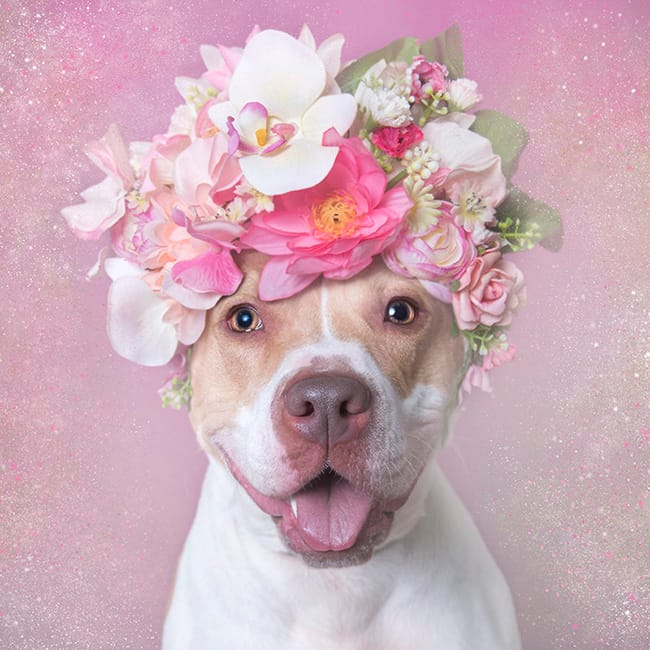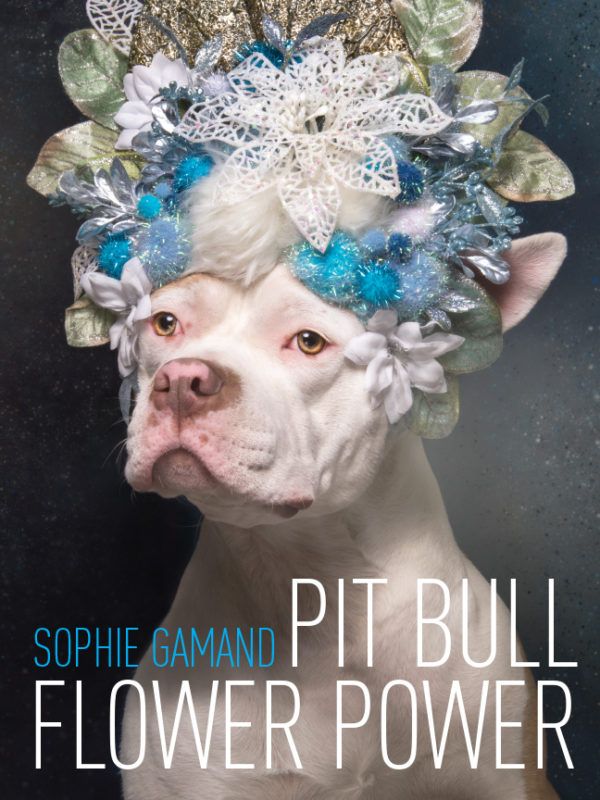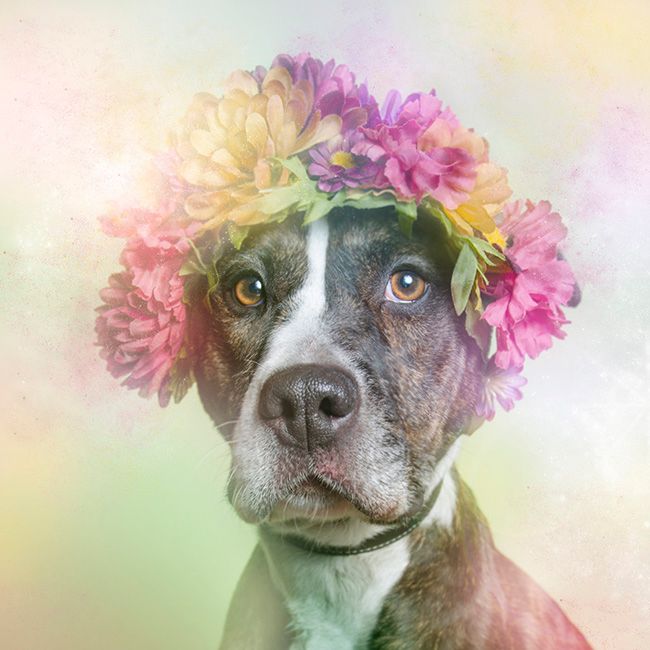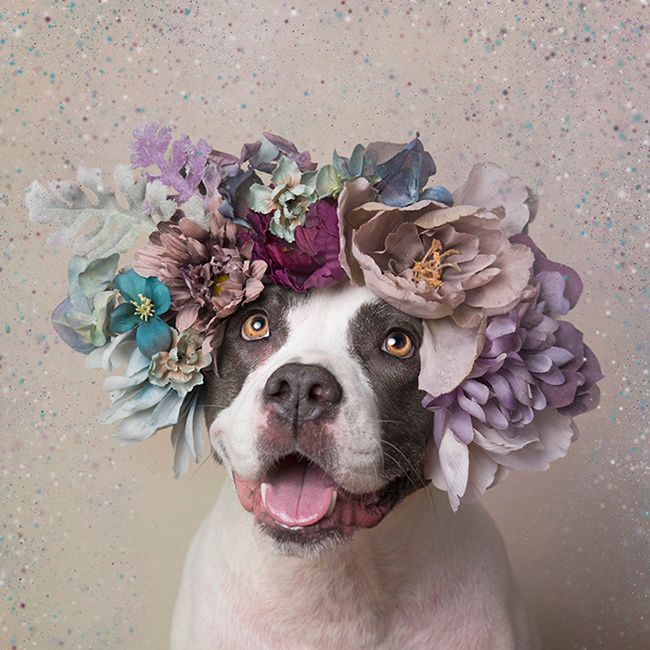Pit Bull Flower Power: Portraits Show Another Side To Feared Dogs

COBBLE HILL – Growing up in Lyon, France, there were two things Sophie Gamand loved to do—play with animals and create art. Today, she uses her artistic talents to create charming, playful portraits of pit bulls that show a different side to the commonly feared dogs.

“I always had a connection with animals. I was a shy child growing up. I was super creative and lonely, so I would either create art or hang out with animals,” she explained on a sunny morning last week in the garden of The Invisible Dog Art Center in Cobble Hill. The gallery will host an event on Saturday, October 20 to celebrate Gamand’s site-specific art installation as well as the release of her new book, Pit Bull Flower Power.
In an effort to find adoptable dogs homes, the artist has shot approximately 500 portraits in her distinctive series that features pit bulls from shelters across the country donning vibrant, elaborate flower crowns handcrafted by Gamand herself. Her photographs are both joyful, funny, and heartbreaking, depending on the range of emotions she elicits from her models and captures on print. Some of the dogs appear to be smiling widely for the camera while others look more reserved and serious, as if aware that their lives are at stake.
Gamand came to Brooklyn with her husband in 2010, first moving to Cobble Hill for six years before settling in Brooklyn Heights. “Moving to New York, my English was not great. I didn’t know anybody, everything was overwhelming,” she recalls. “I had my camera. I started taking photos of people in the street, and quickly noticed I was taking photos of dogs mostly.”

Gamand studied law and opera singing in Europe. In Brooklyn, she signed up for a photography course in which her first assignment was to go around her neighborhood and document a stranger’s life. Gamand decided to go to her local veterinary hospital, the Cobble Hill Animal Clinic which has since closed, and asked if she could take pictures of the furry clients. Gamand became friendly with the clinic’s owners and documented their work for a couple of years. Her At the Vet series can be seen at her website along with a photograph of Sebastian, a handsome blue-eyed pup whom she encountered during her first visit to the veterinary hospital. As she sat there waiting for a response from the owners on whether she could shoot on the premises, Sebastian curiously poked his head out from behind a door.
“There was something super captivating about him that really sparked my interest,” she remembers of the dog who started it all and ignited her desire to explore the “completely codependent relationship” people have with their dogs.
While documenting the Cobble Hill Animal Clinic, Gamand met the founder of the Sato Project and began volunteering with her in 2011, traveling to Puerto Rico to help feed, rescue, and photograph the island’s large stray dog population. “It was a pretty intense two years but it taught me a lot about the rescue world,” she says. Following this stint, Gamand decided to work with shelters, where she could photograph dogs who had already been saved, vetted, and were ready for adoption—they just needed the right photo to show the world they were available.

“When I left the [Sato Project] I wanted a higher pace but I also wanted to find my voice. I wanted to figure out what made me happy, so I started volunteering in shelters,” she explains. “The first one I went to was Animal Haven in Soho and I’ve been working with them since. I think October 2013 was my first shoot with them.”
The Invisible Dog Art Center will host a fundraiser for Animal Haven on Thursday, October 18 (6pm to 9pm) on the opening night of Gamand’s exhibition. “They’re an amazing shelter,” she says. “I really love them.”
To avoid becoming attached to her models when photographing shelter dogs, Gamand tries not to engage too much with the animals, but sometimes the dogs make it difficult. She remembers a black fluffy terrier at Animal Haven who was not yet comfortable with the staff and would snap at them. “I put my camera down and she ran to me and she got on my lap,” Gamand remembers. “She hadn’t done this to anyone. She just curled up into a little ball and looked at me. That one was hard because she chose me.”

Looking to photograph subject matter “a little lighter,” in Fall 2013 Gamand set up a studio at a grooming shop where she shot her first successful series, Wet Dog, a humorous set of portraits of soaking wet dogs taken during bath time. Along with going viral online, her Wet Dog series won the Portraiture category at the prestigious Sony World Photography Awards in 2014. Winning the award gave Gamand a boost in confidence and she says, “validated the work I was trying to do…. I wanted to capture their spirit, their personalities and for me it was a way to revolutionize our relationships with dogs and the way we photograph them and engage with them.”
Working with shelters, Gamand learned that pit bulls are the most commonly euthanized dogs. “In America alone, hundreds of thousands of pit bulls are euthanized every year,” she writes on her website. She wanted to do something to help these “most feared, hated, and abused of all companion animals,” while confronting her own fears as well. At 12- or 13-years-old, Gamand was mauled by a Briard, leaving her uncomfortable with larger dogs, including pit bulls.
“I decided to do a project on pit bulls that would force me to be intimate with them, to touch them, and get over that fear,” she explains. “I wanted to photograph them in a way that had never been done before. I wanted to completely reverse the way we saw pit bulls. My idea was to use art as a tool to rebrand,” she says, and force people to question, “If this was the only image we knew of pit bulls, could we still be afraid?”
“It was for me to overcome my fear,” she adds. “It was to break the image these dogs have.”

Gamand began her Pit Bull Flower Power project at Sean Casey Animal Rescue in Windsor Terrace. “We had an amazing [first] shoot. From the first dog, Baby, whose story I tell in my book, I just realized I had something but I just never knew it was going to be so big,” she recalls.
The dogs in her portraits genuinely seem to enjoy hamming it up for the camera in their headwear, however Gamand insists, “If they really hate it, I don’t do it. I never force dogs with the flower crowns,” adding that she uses sounds and treats to get her models to cooperate.
When Gamand posted her first Pit Bull Flower Power images online in Summer 2014, those also went viral, bringing millions of Facebook views and interview requests. The artist has received messages from fans telling her that she has changed their opinions about the dogs or has convinced them to foster or adopt pit bulls. Gamand says she found herself in an unexpected position “put into this role as pit bull advocate” and as a “new champion for pit bulls” when she was still reckoning with her own fears about the dogs and questioning whether they were safe.

She has since overcome her fears through exposure, photographing nearly a thousand pit bulls, fostering dogs, observing her friends with their own dogs, and “basically slowly coming to [her] senses.”
“Fear makes us make crazy decisions, like passing BSL Laws [Breed-Specific Legislation] that bans pit bulls [in cities like Miami],” she notes. “Those are decisions that we make out of fear and that are completely irrational. I didn’t want to be irrational.”
The term pit bull encompasses various breeds “descended from bulldogs and terriers,” including the American Pit Bull Terrier, American Staffordshire Terrier, Staffordshire Bull Terrier, and American Bully. “We can’t design laws if we can’t define the subject of the law,” the former law student argues. “How do we define pit bulls? Over the decades, a pit bull has become a synonym for a scary looking dog, a terrier of some kind. If you look at my series, if you look at the portraits, [the dogs] look so different.”
Gamand explains when she goes to a shelter she instructs the staff, “bring me pit bulls you think will have problems getting adopted.” They bring her a variety of very different looking dogs every time. “I think the fact that we are unable to really have a strict definition of what a pit bull is is problematic if you are going to design laws around it because it is completely subjective.”

“One of the big problems that pit bulls have is [that] for a long time they attracted bad owners for the wrong reasons, [they] wanted a scary looking dog and [they] encouraged that scary behavior,” she continues. Gamand believes the solution is teaching “people and our politicians” that they need to “judge dogs as individuals…just like humans.”
She agrees that dangerous dogs “need to be addressed,” and adds, “Any dangerous dog—big, small, pit bull, Pomeranian, any dangerous dog—needs to be addressed in a humane way. Any dog can be dangerous.”
“If they bit somebody, let’s try to understand why. Is it something we can fix, or is the dog too far gone? I have no problem with the idea of euthanizing dogs that have become too dangerous,” she adds.

While visiting the Riviera Rescue in Mexico during a family vacation earlier this year, Gamand met a “gorgeous red pit bull” whom she connected with immediately. Frida came from an impoverished neighborhood in Mexico. A volunteer from a local spay-and-neuter group found her dragging her back legs. Her owners claimed to not know how she had become paralyzed. The volunteer group took Frida to physical therapy in an attempt to help her walk again, but after her condition failed to improve, her owners surrendered her and she was taken to Matteo at the Riviera Rescue where he takes in “unadoptables,” dogs who are sick, injured, and routinely rejected.
“She’s very special to me,” Gamand said fondly. “Well, first her name is Frida which is perfect for the flower crowns.” The dog’s namesake, Frida Kahlo, often wore similar floral headdresses. “There was something about her that captured me entirely and I was like, ‘I don’t think I can leave her behind,’” Gamand recalls. The artist typically does not pull dogs from shelters herself, saying “I don’t feel like that’s my job. I connect people [to the dogs],” but there was something about Frida that compelled her to make an exception.
Animal Haven helped Gamand bring Frida to New York. Matteo accompanied Frida on her border-crossing journey because Gamand “did not want her to fly on her own.” The dog was provided with a set of wheels and physical therapy. “I fostered her for a while and was so in love with her,” Gamand says. Even her own rescue dog, MacLovin, who doesn’t get along with big dogs, quickly “grew to love her.” Frida was eventually adopted by a couple in Ohio, but Gamand keeps her close carrying a covetable tote bag with the dog’s gentle visage printed on it.
The artist mentions that despite Frida being paralyzed, her original owners in Mexico wanted to breed her, but when the volunteer group took her for a medical exam they found she had pyometra, a life-threatening infection of the uterus. She was spayed soon after the diagnosis. Gamand recalls that they wanted to breed Frida because the dog was “very special” and “they wanted more dogs like her.”
“That’s what interests me in the rescue world, the grey area,” Gamand notes. “Everybody does the best they can. I am the type of rescue advocate who really wants to emphasize compassion, for animals and humans too. We’re all in this together.”
Sophie Gamand’s book Pit Bull Flower Power will be published Saturday, October 27 by Lantern Books.
The Pit Bull Flower Power exhibition will be on view at The Invisible Dog Art Center, 51 Bergen Street (between Smith Street & Boerum Place), Cobble Hill Thursday, October 18 though Sunday October 21
(Book release party: Saturday, October 20, 4pm to 7pm)



